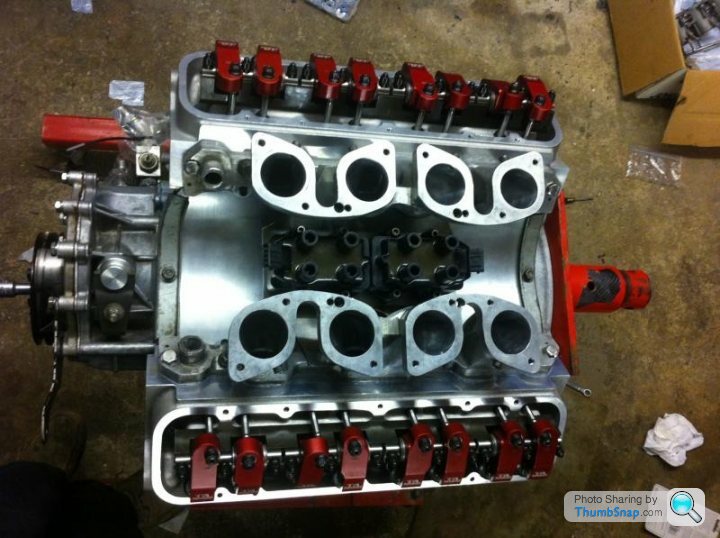Intake manifold and porting...
Discussion
ClassiChimi said:
You lot are the b ks.
ks.
I only understand all this because I read an induction and porting book for Ford X flows when I was about 15 years of age!
I havnt been on here much the last few months, but what a brill topic.
I live and learn. Mega.
I've been thinking of buying a motorbike but maybe I could just put carbs on the Chim? !!! ?
Best of both worlds.
As usual your all an inspiration . Alun
Late bike intakes systems have no such downsides (well not since the 80's)  ks.
ks. I only understand all this because I read an induction and porting book for Ford X flows when I was about 15 years of age!
I havnt been on here much the last few months, but what a brill topic.
I live and learn. Mega.
I've been thinking of buying a motorbike but maybe I could just put carbs on the Chim? !!! ?
Best of both worlds.
As usual your all an inspiration . Alun
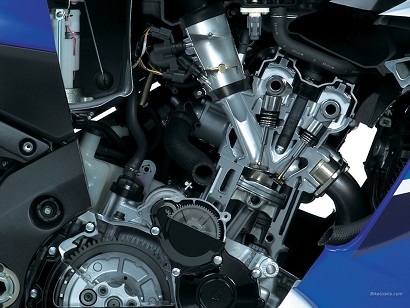

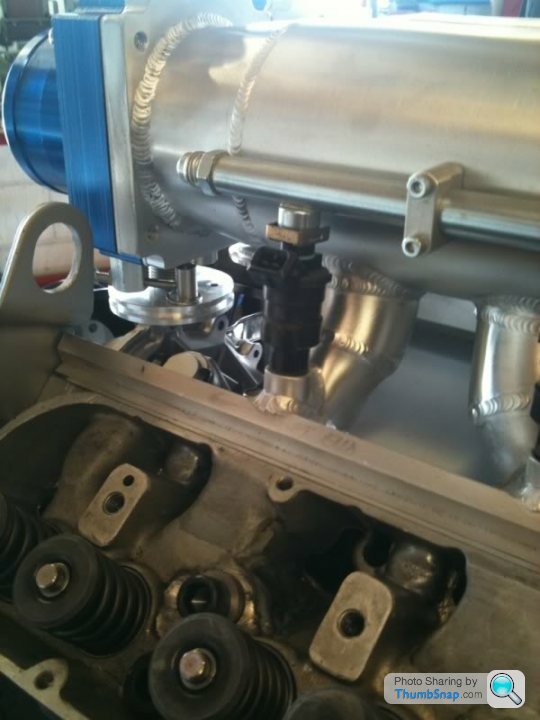

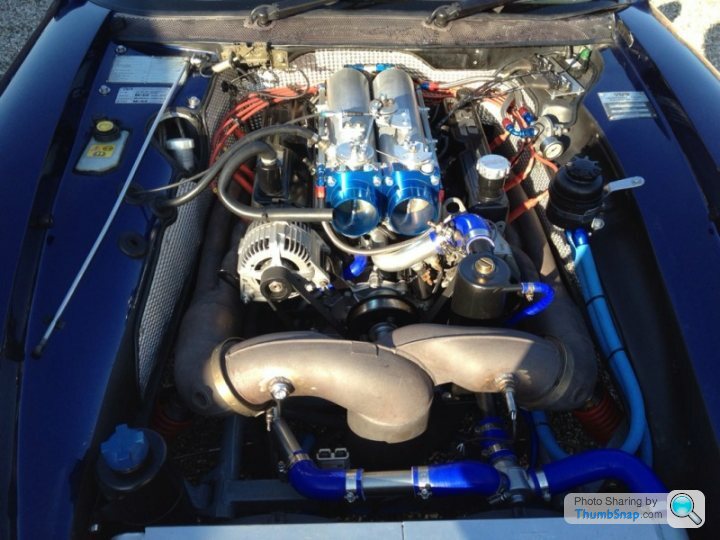
I recon this should do the job. Wonder how much it would cost to knock up.
As Spend says our intake manifold aint good. Outer cylinders will end up running richer than inner ones due to less air. Not good for power or the engine. I mean which ones will be burning correct, dont want any holed pistons.
Woah. 65% airflow difference in the manifold doesn't translate into a 65% inbalance into the chambers .. if it did we would all be melting engines right left and centre and they would be undriveable on anything approaching large throttles.
This therefore suggests that the inlet has small influences on power and cylinder filling discrepencies are not that great in the real world.?
What we need is a complete inlet system mounted together and flow tested on each inlet port on a flow bench, or an engine run on a dyno and each cylinder cut in turn to measure the power loss from each cylinder. Only then would you see the true picture.
This therefore suggests that the inlet has small influences on power and cylinder filling discrepencies are not that great in the real world.?
What we need is a complete inlet system mounted together and flow tested on each inlet port on a flow bench, or an engine run on a dyno and each cylinder cut in turn to measure the power loss from each cylinder. Only then would you see the true picture.
spitfire4v8 said:
Woah. 65% airflow difference in the manifold doesn't translate into a 65% inbalance into the chambers .. if it did we would all be melting engines right left and centre and they would be undriveable on anything approaching large throttles.
This therefore suggests that the inlet has small influences on power and cylinder filling discrepencies are not that great in the real world.?
What we need is a complete inlet system mounted together and flow tested on each inlet port on a flow bench, or an engine run on a dyno and each cylinder cut in turn to measure the power loss from each cylinder. Only then would you see the true picture.
WOW that is a lot I must admit, still never known a restriction in airflow to burn up an engine , a bit of richness never did any harm.This therefore suggests that the inlet has small influences on power and cylinder filling discrepencies are not that great in the real world.?
What we need is a complete inlet system mounted together and flow tested on each inlet port on a flow bench, or an engine run on a dyno and each cylinder cut in turn to measure the power loss from each cylinder. Only then would you see the true picture.
I think the following is correct given the existing parameters, (Joolz will correct me if I'm wrong).
When Joolz mapped my car and it produced 385 bhp, max power was at only about 80% throttle opening.
The restriction bring the heads/inlet manifold.
The manifold and trumpet base are the ACT 45mm items that come with their Triple plenum with a 4" inlet tube and a larger then standard Pipercross filter.
That's all I got!
When Joolz mapped my car and it produced 385 bhp, max power was at only about 80% throttle opening.
The restriction bring the heads/inlet manifold.
The manifold and trumpet base are the ACT 45mm items that come with their Triple plenum with a 4" inlet tube and a larger then standard Pipercross filter.
That's all I got!
spitfire4v8 said:
What we need is a complete inlet system mounted together and flow tested on each inlet port on a flow bench, or an engine run on a dyno and each cylinder cut in turn to measure the power loss from each cylinder. Only then would you see the true picture.
Really??? when you cut a cylinder it's not going to have any effect on the other ports positive or negative??? so what would you actually be measuring? Same with a flow bench ~ measuring flow does not equate to the effects when 8 ports are stopping + starting in sync?
IIRC Pete being reasonably happy using water as a test medium (inertia + momentum) & as mentioned before he does have qualifications on the subject (Phd Thesis as well as his published books & he has his own flow bench + dyno). As I gleaned from Pete (& hopefully understood correctly) its easy to measure a single element but often the complexity is in the interactions with all the other elements and that becomes the challenge (I was actually really surprised he didn't strongly advocate the flow bench). For sure a completed solution can be evaluated by seeing the output on the dyno, but attempting to use the dyno or flow bench to evaluate small changes in a single cylinder can (likely will) lead to GIGO conclusions.
carsy said:
...
I recon this should do the job. Wonder how much it would cost to knock up.
As Spend says our intake manifold aint good. Outer cylinders will end up running richer than inner ones due to less air. Not good for power or the engine. I mean which ones will be burning correct, dont want any holed pistons.
These are great in terms of equalizing runners, I'm still not convinced the 'tube' with throttles on the front is the best design for flow, and there is no separation to split supply evenly (ie 5 then 7 overlapped sucking)...I recon this should do the job. Wonder how much it would cost to knock up.
As Spend says our intake manifold aint good. Outer cylinders will end up running richer than inner ones due to less air. Not good for power or the engine. I mean which ones will be burning correct, dont want any holed pistons.
More importantly IMHO, the plenum also has an important secondary function of bracing the heads and making the whole block structurally strong (FAR more important than crossbolting I'd say). So I wouldn't consider something like that without adding bracing across the heads (front & rear) ~ but that adds extra complexity redesigning alternator mounts... ~ yes I've been through that design & have working parts. The same problem applies to most throttle bodies, and is one good point that can be made for the JE crossover manifold.
spend said:
spitfire4v8 said:
What we need is a complete inlet system mounted together and flow tested on each inlet port on a flow bench, or an engine run on a dyno and each cylinder cut in turn to measure the power loss from each cylinder. Only then would you see the true picture.
Really??? when you cut a cylinder it's not going to have any effect on the other ports positive or negative??? so what would you actually be measuring? Same with a flow bench ~ measuring flow does not equate to the effects when 8 ports are stopping + starting in sync?
IIRC Pete being reasonably happy using water as a test medium (inertia + momentum) & as mentioned before he does have qualifications on the subject (Phd Thesis as well as his published books & he has his own flow bench + dyno). As I gleaned from Pete (& hopefully understood correctly) its easy to measure a single element but often the complexity is in the interactions with all the other elements and that becomes the challenge (I was actually really surprised he didn't strongly advocate the flow bench). For sure a completed solution can be evaluated by seeing the output on the dyno, but attempting to use the dyno or flow bench to evaluate small changes in a single cylinder can (likely will) lead to GIGO conclusions.
What I was getting at is that you said the flow disparity was 65% .. if you're mapping a car and the co probe is up the exhaust you have an average mixture .. if the 65% flow disparity was seen t any great extent at the ports then from a mean co at the tailpipe you'd have some chambers 30% rich and some 30% weak .. instant meltdown. What I'm getting at is that your take on this seems to be fundamentally flawed by getting bogged down in things that in the real world seem to be of very little importance, ie the relative flow rates of the intake in comparison to the flow of the total system.
Certainly measuring flow doesn't tell you the whole picture as regards the power capability of a system, but the flow bench is where 90% of developement is done certainly in the early stages, as vizard states in his books of 3-4decades ago you can make a pretty good prediction of the power capability of an engine by looking at the flow rates, but more importantly the flow rates of the restrictive parts of the system. I think we can safely say that in RV8 terms the manifold porting isn't one of the more restrictive parts of the system when compared to the ports themselves.
I'm not sure you're keeping sight of your own argument here ..
Edited by spitfire4v8 on Sunday 14th December 15:01
spitfire4v8 said:
What I was getting at is that you said the flow disparity was 65% .. if you're mapping a car and the co probe is up the exhaust you have an average mixture .. if the 65% flow disparity was seen t any great extent at the ports then from a mean co at the tailpipe you'd have some chambers 30% rich and some 30% weak .. instant meltdown. What I'm getting at is that your take on this seems to be fundamentally flawed by getting bogged down in things that in the real world seem to be of very little importance, ie the relative flow rates of the intake in comparison to the flow of the total system.
I'm not sure you're keeping sight of your own argument here ..
I think you maybe misguided in thinking flow is directly proportional to charge volume ~ it isnt. I'd guess 65% less flow as per my water test is going to result in something like 4-8% less air in that cylinder in operation. Which I suspect is the number that you've been wanting rather than flow?I'm not sure you're keeping sight of your own argument here ..
My only argument is that having any manifold that makes a difference to the air that gets into each cylinder is not ideal. How much / how bothered you are / how you address it, I don't really have any strong opinions or arguments to make, I thought we were just throwing points to consider into the melting pot fort those that have 'open' minds and are thinking of doing their own modifications.
I'll keep quiet if you want to insist that the RV8 manifold is fine, but even if something works OK in everyones opinion it still doesn't mean it can't be improved upon or that we should discourage people from trying?
Bobby Shaftoe said:
I think a throttle butterfly increase is well worth it, i've seen a restriction in airflow from the stock 65mm plate at around the 250bhp mark. But as i said early in the thread, a standard inlet manifold is capable of 190 cfm with slight porting while retaining the standard 38mm port size at the trumpet base end. There's only two runners in the inlet manifold that have the somewhat restrictive dogleg kink, the other six runners have a straight shot, and consider that the best ported rover V8 heads (based on standard rover V8 castings) only flow around 170cfm i'm struggling to see that there could be any substantially benefit to opening the runners out to ~45mm at the trumpet base end.
This is evidence that 45mm does work. AIUI this graph shows Griffdudes 4.5 going from 38mm to a ported inlet manifold and one of Jools`s 45mm blended bases. Increase everywhere and 20bhp at the top end.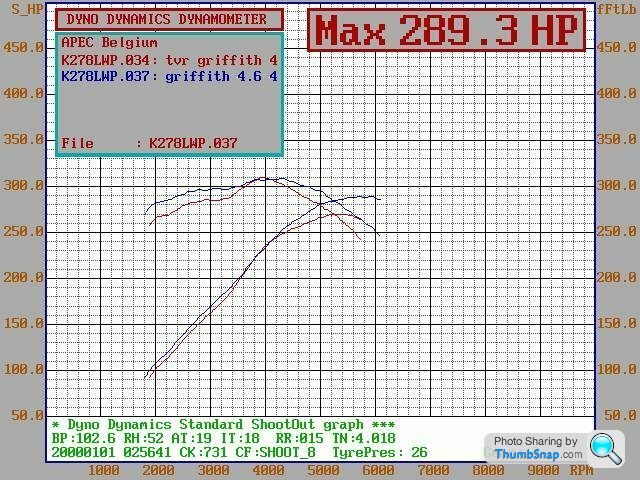
I'm not being misguided in the slightest, it was you who brought up the 65% flow disparity as significant not me, I was pointing out that it is largely insignificant in terms of the whole system.. I was pointing out that other factors in the inlet are of far greater significance. I'm pleased you've come round to common sense.
carsy said:
This is evidence that 45mm does work. AIUI this graph shows Griffdudes 4.5 going from 38mm to a ported inlet manifold and one of Jools`s 45mm blended bases. Increase everywhere and 20bhp at the top end.

Ideally, you would need to test each component individually to determine which one causes the increase in BHP.
- standard trumpet base and intake manifold
- blended base and standard 38mm intake
- standard trumpet base and 45mm intake
- blended base and 45mm intake.
A lot of work, but it would be interesting to see which part of the intake would make the largest increase. In my case, I was asking whether I would see a real world increase from 44mm to 45mm. However, this aside, it is the trumpet base that appears to be the most important thing, to help increase the speed the airflow.
Having contacted V8D, they said they've never tested the 45mm intake manifold by itself, only in conjunction with the 45mm trumpet base. However, there have been plenty of tests with trumpet bases by themselves, which appear to yeald good results (including the rather lovely looking blended base).
Reading between the lines (and I am probably comletely wrong), if there was a huge increase to be had between the intake manifolds, then these would have been individually tested and marketed as such to increase revenues of the companies that produce them. It is easy to sell two items for around £400 on the back of a 15/20BHP increase, but more difficult to sell one for 200 that may only yeild 1-2bhp, whilst the other for the same price that gives you a potental 14-18bhp. Intake or trumpet base, which is it? Chicken and egg....
There is probably a noticeable increase from 38-45mm, but still nobody can quantify (not even V8D) the difference in BHP the intake manofold makes. It appears that nobody has tested the 38/44/45mm back to back too see what BHP or torque increase they give. So my original question wa, would there be a difference in output between my 44mm and 45mm intakes? Not even V8D could tell me the answer. If somebody has a RR and the time, then I'd happily spend a day with them and use my Chim to see if there was a difference and what that difference i
Edited by Chuffmeister on Sunday 14th December 18:51
Bobby Shaftoe said:
Thanks carsy i was hoping someone would come up with some evidence, any idea what heads and throttle plate size this guy is running?
ETA - and by blended base, do you mean a base with no trumpets at all?
http://www.kitsandclassics.co.uk/engine-ecu/#conte...ETA - and by blended base, do you mean a base with no trumpets at all?
Edited by Bobby Shaftoe on Sunday 14th December 18:52
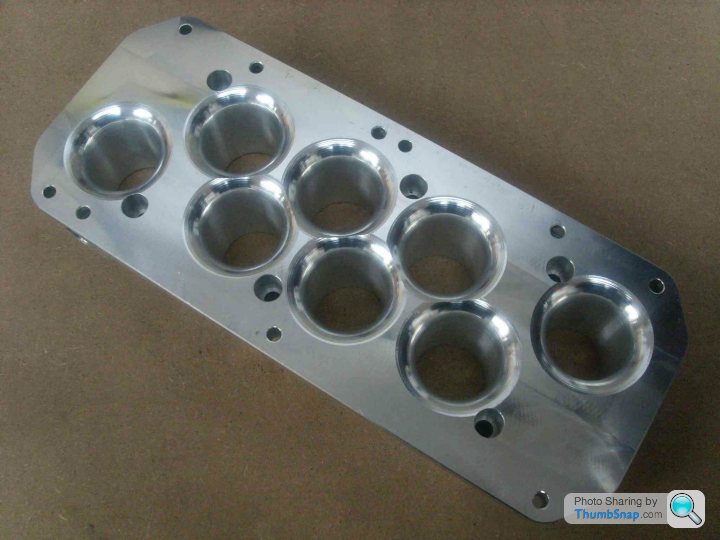
Edited by Chuffmeister on Sunday 14th December 19:00
spitfire4v8 said:
I'm not being misguided in the slightest, it was you who brought up the 65% flow disparity as significant not me, I was pointing out that it is largely insignificant in terms of the whole system.. I was pointing out that other factors in the inlet are of far greater significance. I'm pleased you've come round to common sense.
I'm not sure about that Joo, I just put it down to you picking up & dropping threads whilst working  maybe illustrating the salient exchanges might help refresh your memory
maybe illustrating the salient exchanges might help refresh your memory 
spitfire4v8 said:
The final thing is that the engines themselves seem to be very mixture tolerant, in that you can change the mixture considerably and still make the power .. what is the flow discrepency of a high power RV8 once the inlet is on the head, port to port? Is it more than 10%? because you'd need that much to influence the mixture enough to reduce power over how you'd map it conventionally I'm guessing (based on power outputs of cars with varying mixtures, and how they react once the mixture is corrected) *ie a drop from lambda 0.85 to lambda 0.95 would drop power.
spitfire4v8 said:
ah sorry i thought we were on about mixture variance due to the differences in flow of the inlet runners .....
spend said:
I did flow test a manifold into bores, and observed one of the outers was roughly 65% of the inners... Using water down the trumpets & timing a known volume. ...
spitfire4v8 said:
Woah. 65% airflow difference in the manifold doesn't translate into a 65% inbalance into the chambers .. if it did we would all be melting engines right left and centre and they would be undriveable on anything approaching large throttles.
This therefore suggests that the inlet has small influences on power and cylinder filling discrepencies are not that great in the real world.?
Strange that you felt it necessary to make that (obvious) point that flow is not the same as fill, particularly after it was a specific answer to a question you yourself asked. Figured OK maybe some readers might need hints dropped and you were being helpful.. I guessed most as well understood that you meant 35% difference (100-65) and there was no confusion that I had said it was 65% of the flow..This therefore suggests that the inlet has small influences on power and cylinder filling discrepencies are not that great in the real world.?
spitfire4v8 said:
What I was getting at is that you said the flow disparity was 65% .. if you're mapping a car and the co probe is up the exhaust you have an average mixture .. if the 65% flow disparity was seen t any great extent at the ports then from a mean co at the tailpipe you'd have some chambers 30% rich and some 30% weak .. instant meltdown. What I'm getting at is that your take on this seems to be fundamentally flawed by getting bogged down in things that in the real world seem to be of very little importance, ie the relative flow rates of the intake in comparison to the flow of the total system.
...
I'm not sure you're keeping sight of your own argument here ..
Pretty confused how I can be accused of 'losing sight' I'm quite clear (and have been throughout the thread) what flow is & the difference it makes to cylinder filling and they are nothing like the 1:1 ratio your extrapolation of my 65% flow to 30% rich & 30% weak. I'm still not sure if you understand the original 65% flow vs 100% means 35% difference so +/- 17.5% with your delusional extrapolation or if because you write "30% rich and some 30% weak" that that is some transformation of 65% into +/-30% mixture???? ...
I'm not sure you're keeping sight of your own argument here ..
So I'll repeat very simply I poured just over 1 litre of water down each inlet trumpet, starting the clock when I pressed the inlet valve open, and stopping the clock when the water reached an index mark in the cylinder (clear plastic cup). On analysis the best cylinders filled in say 10 secs, and the worst in 16.5 secs so the poor cylinder was flowing at 65% of what the best did (ie 35% less flow). Apart from that all I've said is that that is proof that the inlet manifold does not provide equalized flow, and have at no stage suggested that flow equals cylinder filling or what the equation that relates them maybe (only that it IS a very complicated dynamic one that requires a full engine CFD model). I think the only real point I've made is that equal fill across cylinders would be ideal, failing that being able to trim fuel delivery (per cylinder) to take account of it would be useful, and that there seems a big discrepancy in the lengths folks go to in cc'ing heads yet relatively ignore the inlet manifold.
If I really am the one going barking here, please let me know as I'd probably be the last one to see it

Chuffmeister said:
website said:
Back to back testing compared to the standard TVR 5litre trumpetted version but gains a clear 10bhp at the top end.
Not exactly difficult when you consider the std tvr "scaffold tube" manifold:
Why no back to back comparison against ACT carbon trumpets...
FWIW - I made one of these a long time ago on my 40 year old EMC milling machine (EliotMachineControl)
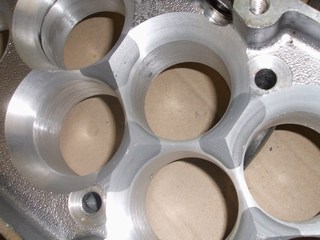
I ground the cutter myself.
Edited by eliot on Sunday 14th December 21:42
Ah yes spend I agree what you had written was clear and i had cocked that 65% bit up, apologies for that. I still maintain the effect of the inlet is minimal though when compared to the head ports themselves which are the known bottleneck .. I don't think people should get hung up over the manifold flow differences when there's far greater issues to concern onesself with.
Eg a 5 litre I tested on a plenum made just over 350hp and the exact same engine on throttle bodies makes 370 .. so less than 20 hp on a 350plus hp engine for going from something that *looks* flawed to something that is developed with the intention of making more power .. seems to illustrate that the manifold isn't something to concern anyway not absolutely hell bent on extracting the last bit from their engine.
Eg a 5 litre I tested on a plenum made just over 350hp and the exact same engine on throttle bodies makes 370 .. so less than 20 hp on a 350plus hp engine for going from something that *looks* flawed to something that is developed with the intention of making more power .. seems to illustrate that the manifold isn't something to concern anyway not absolutely hell bent on extracting the last bit from their engine.
spitfire4v8 said:
Ah yes spend I agree what you had written was clear and i had cocked that 65% bit up, apologies for that. I still maintain the effect of the inlet is minimal though when compared to the head ports themselves which are the known bottleneck .. I don't think people should get hung up over the manifold flow differences when there's far greater issues to concern onesself with.
Eg a 5 litre I tested on a plenum made just over 350hp and the exact same engine on throttle bodies makes 370 .. so less than 20 hp on a 350plus hp engine for going from something that *looks* flawed to something that is developed with the intention of making more power .. seems to illustrate that the manifold isn't something to concern anyway not absolutely hell bent on extracting the last bit from their engine.
Must admit when I read that I thought Dav had made a mistake till I see what he was getting at Eg a 5 litre I tested on a plenum made just over 350hp and the exact same engine on throttle bodies makes 370 .. so less than 20 hp on a 350plus hp engine for going from something that *looks* flawed to something that is developed with the intention of making more power .. seems to illustrate that the manifold isn't something to concern anyway not absolutely hell bent on extracting the last bit from their engine.
 didnt mention through fear of looking a tit
didnt mention through fear of looking a tit  then read things AGAIN properly
then read things AGAIN properly  that would have been quickly resolved face to face but the time lapse between typing and reading f
that would have been quickly resolved face to face but the time lapse between typing and reading f ks things up BLOODY COMPUTERS
ks things up BLOODY COMPUTERS 
Gassing Station | Chimaera | Top of Page | What's New | My Stuff





